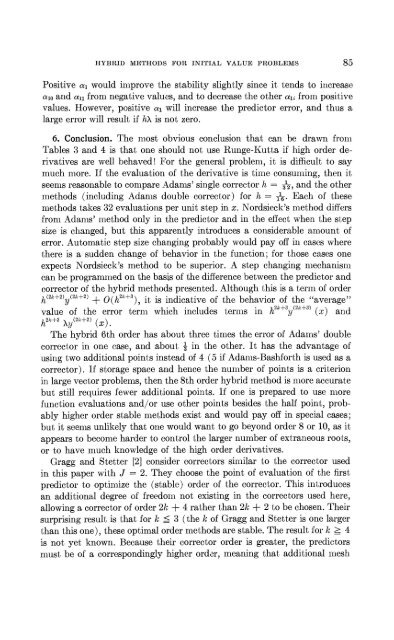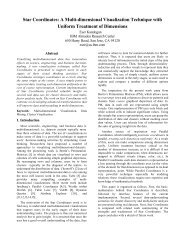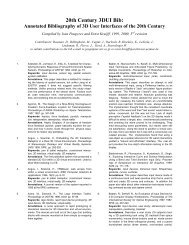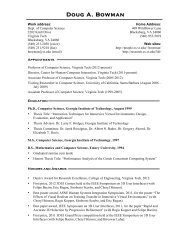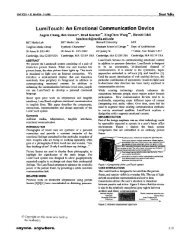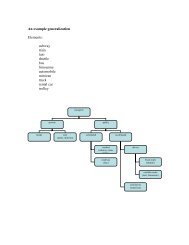Hybrid Methods for Initial Value Problems in Ordinary Differential ...
Hybrid Methods for Initial Value Problems in Ordinary Differential ...
Hybrid Methods for Initial Value Problems in Ordinary Differential ...
Create successful ePaper yourself
Turn your PDF publications into a flip-book with our unique Google optimized e-Paper software.
HYBRID METHODS FOR INITIAL VALUE PROBLEMS<br />
Positive al would improve the stability slightly s<strong>in</strong>ce it lends to <strong>in</strong>crease<br />
a10and all froni negative values, and to decrease the other al, from positive<br />
values. However, positive al will <strong>in</strong>crease the predictor error, and thus a<br />
large error will result if ILX is not zero.<br />
6. Conclusion. The most obvious conclusion that can be drawn fro111<br />
Tables 3 and 4 is that one should not use Runge-Kutta if high order derivatives<br />
are well behaved! For the general problem, it is difficult to say<br />
much more. If the evaluation of the derivative is time consum<strong>in</strong>g, then it<br />
seems reasonable to compare Adanis' s<strong>in</strong>gle corrector h = A,and the other<br />
lliethods (<strong>in</strong>clud<strong>in</strong>g Adan~s double corrector) <strong>for</strong> h = &. Each of these<br />
niethods taltes 32 evaluations per unit step <strong>in</strong> x. Kordsiecli's <strong>in</strong>etllod differs<br />
froni Adams' niethod only <strong>in</strong> the predictor and <strong>in</strong> the effect ~vheii the step<br />
size is changed, but this apparently <strong>in</strong>troduces a co~lsicierable ai~iount of<br />
error. Automatic step size chang<strong>in</strong>g probably would pay off <strong>in</strong> cascs where<br />
there is a sudden change of behavior <strong>in</strong> the function; <strong>for</strong> those cases one<br />
expects Nordsieck's method to be superior. A step chang<strong>in</strong>g niechanislii<br />
can be programmed on the basis of the difference between the predictor and<br />
corrector of the hybrid methods presented. Although this is a term of order<br />
h(2kt+ (2A-2' + 0(hZN3),it is <strong>in</strong>dicative of the behavior of the '.average"<br />
y<br />
value of the error term which <strong>in</strong>cludes ternls <strong>in</strong> h2k+3y'2h-3) (a) and<br />
h2k+3 Xy(2a-2)<br />
(2).<br />
The hybrid 6th order has about three times the error of Adams' double<br />
corrector <strong>in</strong> one case, and about 4 <strong>in</strong> the other. It has the advantage of<br />
us<strong>in</strong>g two additional po<strong>in</strong>ts <strong>in</strong>stead of 4 (5 if Adams-Bash<strong>for</strong>th is used as a<br />
corrector). If storage space and hence the number of po<strong>in</strong>ts is a criterion<br />
<strong>in</strong> large vector problems, then the 8th order hybrid method is iiiore accurate<br />
but still requires fewer additional po<strong>in</strong>ts. If one is prepared to use more<br />
function cvaluations and/or use other po<strong>in</strong>ts besides the half po<strong>in</strong>t, prob-<br />
ably higher order stable methods exist and would pay off <strong>in</strong> special cases;<br />
but it seems unlikely that one would want to go beyond order 8 or 10, as it<br />
appears to become harder to control the larger number of extraneous roots,<br />
or to have much knowledge of the high order derivatives.<br />
Gragg and Stetter [2]consider correctors s<strong>in</strong>lilar to the corrector used<br />
<strong>in</strong> this paper with J = 2. They choose the po<strong>in</strong>t of evaluation of the first<br />
predictor to optimize the (stable) order of the corrector. This <strong>in</strong>troduces<br />
an additional degree of freedo<strong>in</strong> not exist<strong>in</strong>g <strong>in</strong> the correctors used here,<br />
allow<strong>in</strong>g a corrector of order 2k + 4 rather than 21c + 2 to be chosen. Their<br />
surpris<strong>in</strong>g result is that <strong>for</strong> k 5 3 (the k of Gragg and Stetter is one larger<br />
than this one), these optimal order methods are stable. The result <strong>for</strong> 11 2 4<br />
is not yet known. Because their corrector order is greater, the predictors<br />
must be of a correspond<strong>in</strong>gly higher ordsr, mean<strong>in</strong>g that additional <strong>in</strong>esh<br />
85


